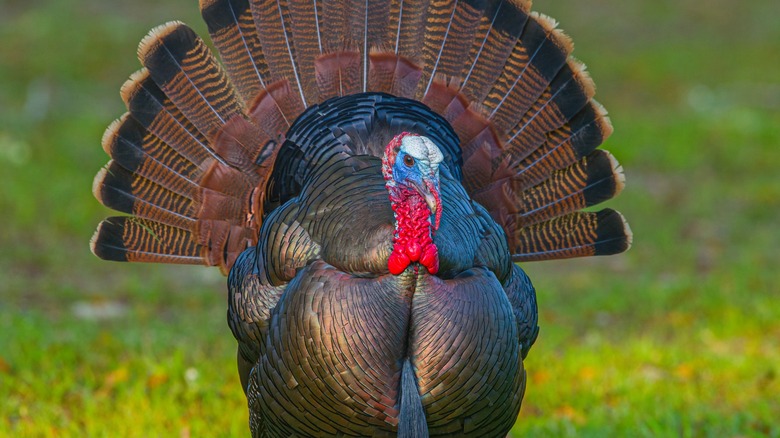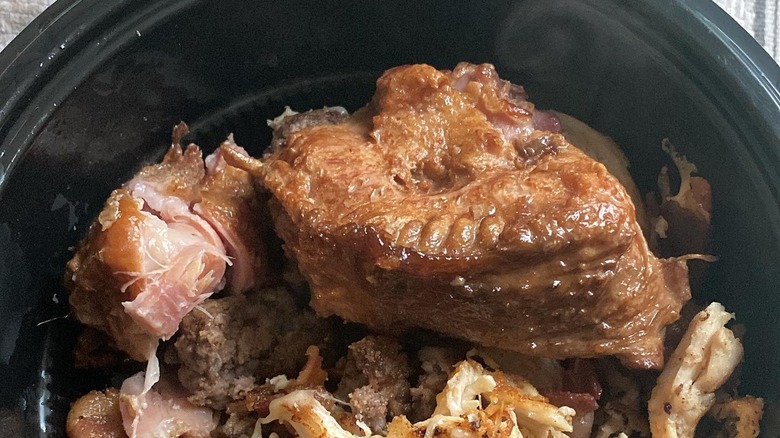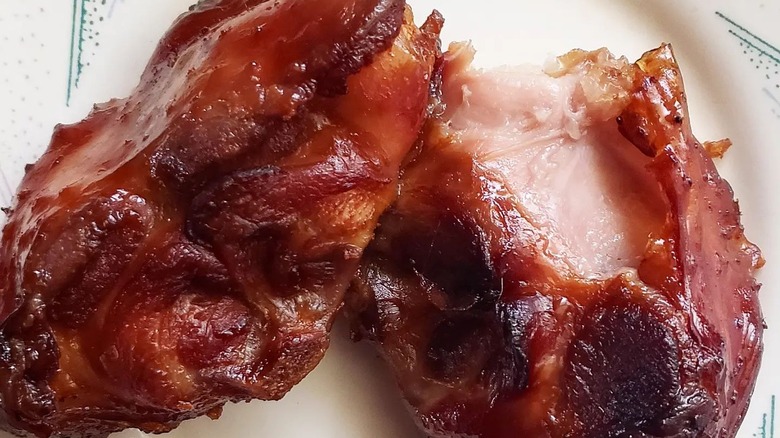The Unconventional Turkey Cut To Stop Ignoring For Culinary Excellence
Why don't we eat turkey tails anymore — not the mushrooms, but the actual bird parts? As a culture, we've ignored this cut of meat to such a degree that many people don't even know it exists. Hunters, farmers, and chefs seem to be relatively well acquainted with this oft-forgotten section of the bird, but, on the whole, Americans don't really eat turkey tails, which is a shame.
In a way, we've pigeonholed the turkey. Many of us only consume it on special occasions, like Thanksgiving or Christmas, but there's far more to these birds than a taste of holiday cheer. Dark meat, like that found in turkey tails, has a far deeper flavor due to its fat content, but Americans prefer white meat, so you won't find it as often in grocery stores.
Though this cut has been cast aside by the poultry industry for decades, it's worth searching out for anyone who loves turkey. See, when you purchase turkey tails, you're in for both a historic and a culinary adventure. Here's why.
What are turkey tails, and who eats them?
Although it's known as the "parson's nose," the "pope's nose," and the "sultan's nose," the turkey tail isn't nasal at all. Rather, it's the gland that attaches a bird's feathers to its body. This gland is oily and fatty, making it a flavorful dark meat. But who actually eats it?
Well, our ancestors did, a long time ago. It was only after World War II that the poultry industry, which had a hand in developing our preference for white meat, decided to discard the tails. Instead of letting them go to waste, however, poultry companies exported the turkey tails to the South Pacific, most notably the islands of American Samoa. There, the meat's novelty and affordability made it incredibly popular — so popular, in fact, that the Samoan government banned the import of turkey tails in 2007, citing health concerns (more on that in a bit). This ban was eliminated in 2013 when Samoa joined the World Trade Organization; these days, turkey tail is a prized food on the islands, although residents are encouraged to eat far less of it than they were before.
Despite Micronesia's preference for these fatty globs, mainland USA has never taken to them. From both a sustainability and a culinary standpoint, this is really too bad.
Worrisome nutrition
Here's the unfortunate truth about dark meat: The thing that gives it such a wonderful flavor is also the thing that makes it less healthy than white meat. Yeah, we're talking about the fat. In moderation, fat is good for the body. It helps process vitamins and minerals, and goes a long way towards aiding digestion. However, excess fat can cause a plethora of health issues, including obesity and Type 2 diabetes.
Looking closely at turkey tails' nutritional data, we see that one 4-ounce tail contains about 36 grams of total fat, 10 grams of saturated fat, and cholesterol and sodium levels that comprise 12% and 9% of your recommended daily value, respectively. That's not the sort of thing you want to be eating regularly, which is why the Samoan government took action after noticing a disturbing trend.
In 2007, Samoa banned the import of turkey tails in an effort to curb the rise of noncommunicable diseases. In addition, many Samoans believed — and still do — that the shift away from traditional Samoan fare like cereal grains and fibers in favor of cheap imported meat like turkey tails resulted in an unhealthy population. At the very least, because of their fatty nature, turkey tails are not the healthiest cut of what is generally considered to be a pretty lean bird.
How to prepare turkey tails
Back when Americans raised their own poultry, turkey tails were probably consumed with the same regularity that modern Americans eat chicken. However, very few turkey tail recipes have become part of the greater American culinary culture.
In Samoa, turkey tails are often simmered for close to an hour in a mix of water, soy sauce, rice wine vinegar, chopped garlic, bay leaves, and black peppercorns. Afterwards, they're drained and grilled, broiled, or roasted until the skin becomes brown and crispy. The tails are then cut and served over a bed of white rice.
Of course, there is always room to experiment. One of the keys to maximizing a turkey tail's flavor is to cook it over low heat, letting the fat render. You can do this in the oven by pan roasting the tails, much as you would a whole turkey. You can also smoke them, which makes the tails quite crispy and brings out the complexity of their flavors. Boiling them over medium low heat also works. You won't get the same crispiness that you would from an oven, but the flavor and tenderness will be there. In any case, aim for an internal temperature between 140 to 145 degrees Fahrenheit.
Where to find turkey tails
Although the majority of turkey tails produced in the United States are shipped abroad, you can find them at a few domestic retailers. The chances of locating turkey tails at the average grocery store are slim, but West Coast stores may stock Foster Farms' offerings. North Carolina-based Villari Foods sells 32-oz packs containing four smoked turkey tails, as does Royal Quality Meats, a 100% domestically sourced operation; the latter also offers regular turkey tails, if you want to use your own recipe. Still, your best bet is to visit a local butcher or farmer.
Another option, albeit a far more labor-intensive one, is to grow your own turkeys. This will appeal to anyone who's looking to get back to the land or who has an interest in raising and butchering their own animals. Growing your own food is the only way to have complete control over what you consume, although we admit that this option probably doesn't appeal to the majority of Americans.
If you're willing to march to the beat of your own drum and consume some irregular meats, try turkey tails. They're packed with flavor and, if you're up for hunting them down, well worth the effort to procure.




